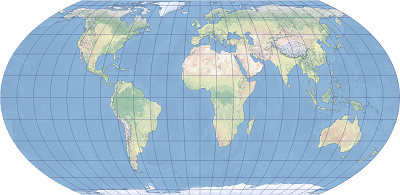Description
Equal Earth is an equal-area pseudocylindrical projection for world maps. Its land features have a pleasing appearance, and its shape is similar to the Robinson projection.
The projection was jointly developed by Tom Patterson, Bernhard Jenny, and Bojan Šavrič in 2018, and it was quickly adopted by the NASA Goddard Institute for Space Studies (GISS). It is available in ArcGIS Pro 2.3 and later and in ArcGIS Desktop 10.7 and later.

Projection properties
The subsections below describe the Equal Earth projection properties.
Graticule
Equal Earth is a pseudocylindric projection. All parallels, the central meridian, and both poles are presented as straight lines. The parallels are unequally spaced. The meridians are equally spaced and other than the central meridian are curved outward. The poles are 0.59247 times the length of the equator. The graticule is symmetric across the equator and the central meridian.
Distortion
Equal Earth is an equal-area (equivalent) projection. Shapes, directions, angles, and distances are distorted and stretched north-south in tropical and mid-latitude areas. Nearer the poles, features are compressed in the north-south direction. Distortion values are symmetric across the equator and the central meridian.
Usage
The projection is appropriate for small-scale mapping, especially for thematic world maps illustrating area characteristics and analysis requiring accurate areas.
Parameters
Equal Earth parameters are as follows:
- False Easting
- False Northing
- Central Meridian
Sources
Šavrič, B., Patterson, T., and Jenny, B. (2018). "The Equal Earth map projection." International Journal of Geographical Information Science, 33(3), p. 454-465. DOI: 10.1080/13658816.2018.1504949